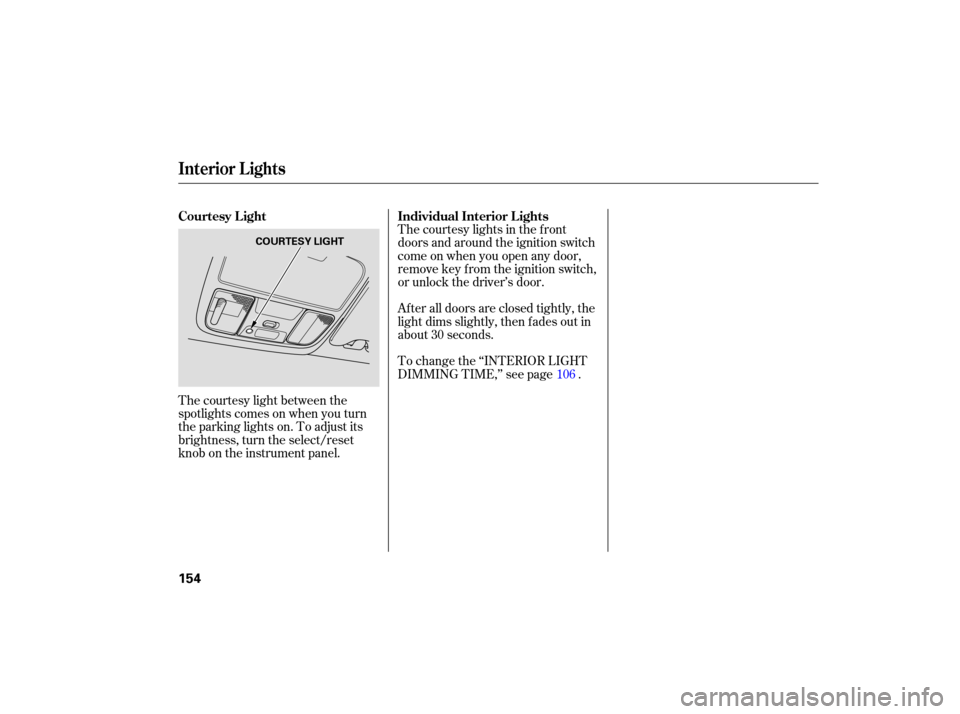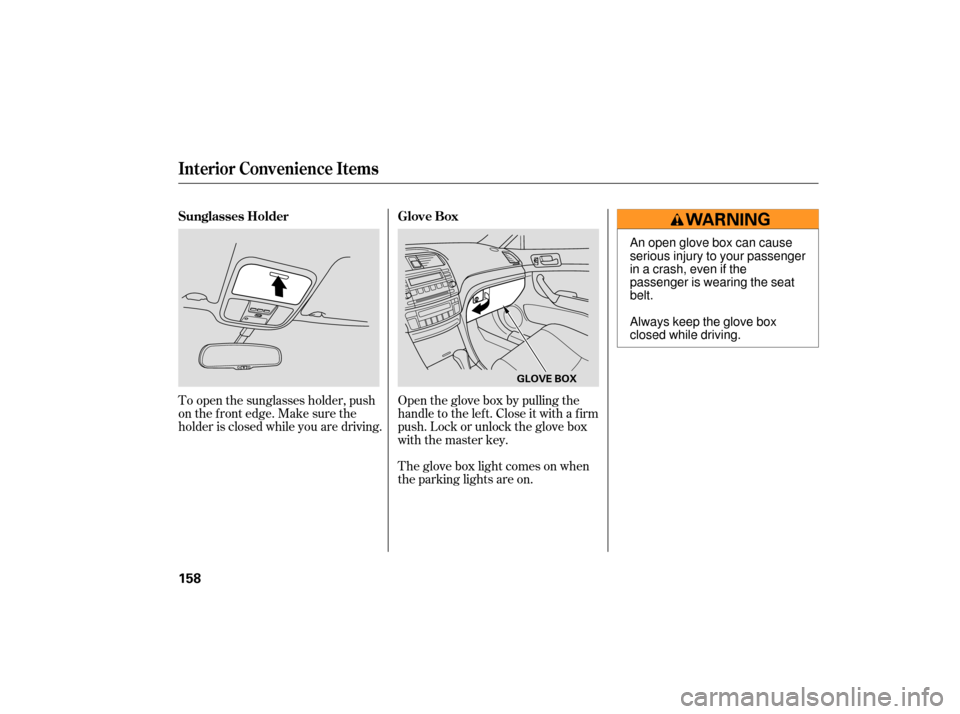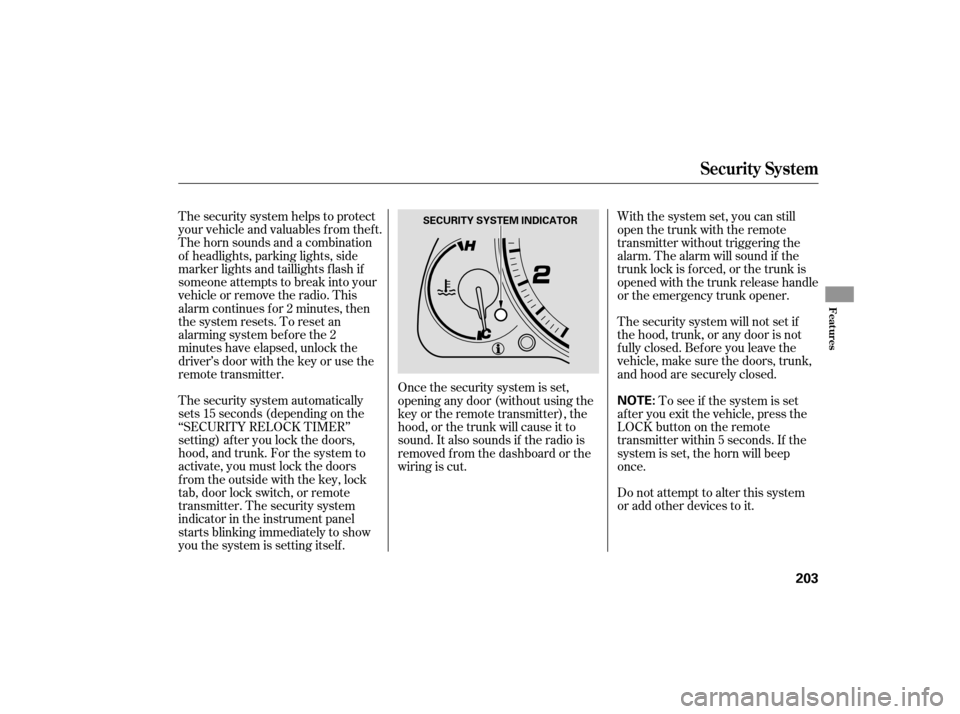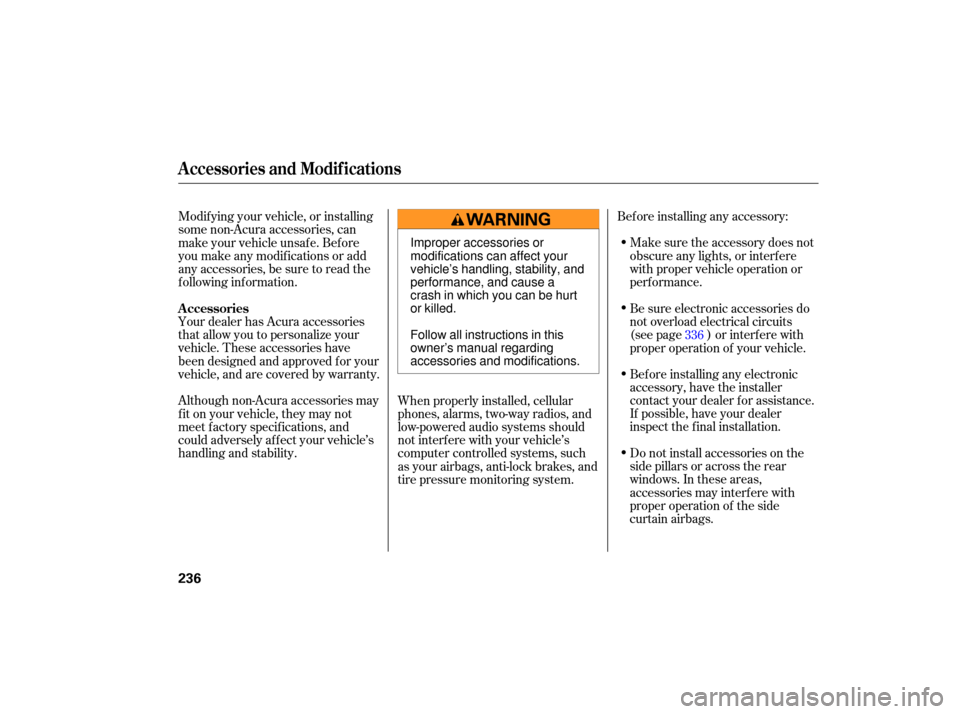lights Acura TSX 2007 Owner's Guide
[x] Cancel search | Manufacturer: ACURA, Model Year: 2007, Model line: TSX, Model: Acura TSX 2007Pages: 379, PDF Size: 5.45 MB
Page 157 of 379

The courtesy light between the
spotlights comes on when you turn
the parking lights on. To adjust its
brightness, turn the select/reset
knob on the instrument panel. The
courtesy lights in the front
doors and around the ignition switch
come on when you open any door,
remove key from the ignition switch,
or unlock the driver’s door.
After all doors are closed tightly, the
light dims slightly, then fades out in
about 30 seconds.
To change the ‘‘INTERIOR LIGHT
DIMMING TIME,’’ see page . 106
Courtesy L ight
Individual Interior L ights
Interior Lights
154
COURTESY LIGHT
Page 161 of 379

Open the glove box by pulling the
handle to the lef t. Close it with a f irm
push. Lock or unlock the glove box
with the master key.
The glove box light comes on when
the parking lights are on.
To open the sunglasses holder, push
on the f ront edge. Make sure the
holder is closed while you are driving. Sunglasses Holder
Glove Box
Interior Convenience Items
158
GLOVE BOX
An open glove box can cause
serious injury to your passenger
inacrash,evenifthe
passenger is wearing the seat
belt.
Always keep the glove box
closed while driving.
Page 206 of 379

The security system will not set if
the hood, trunk, or any door is not
f ully closed. Bef ore you leave the
vehicle, make sure the doors, trunk,
and hood are securely closed.
The security system helps to protect
your vehicle and valuables f rom thef t.
The horn sounds and a combination
of headlights, parking lights, side
marker lights and taillights f lash if
someone attempts to break into your
vehicleorremovetheradio.This
alarm continues f or 2 minutes, then
the system resets. To reset an
alarming system before the 2
minutes have elapsed, unlock the
driver’s door with the key or use the
remote transmitter.
The security system automatically
sets 15 seconds (depending on the
‘‘SECURITY RELOCK TIMER’’
setting) after you lock the doors,
hood, and trunk. For the system to
activate, you must lock the doors
from the outside with the key, lock
tab, door lock switch, or remote
transmitter. The security system
indicator in the instrument panel
starts blinking immediately to show
you the system is setting itself . With the system set, you can still
open the trunk with the remote
transmitter without triggering the
alarm. The alarm will sound if the
trunk lock is f orced, or the trunk is
opened with the trunk release handle
or the emergency trunk opener.
Do not attempt to alter this system
or add other devices to it.
To see if the system is set
af ter you exit the vehicle, press the
LOCK button on the remote
transmitter within 5 seconds. If the
system is set, the horn will beep
once.
Once the security system is set,
opening any door (without using the
key or the remote transmitter), the
hood, or the trunk will cause it to
sound. It also sounds if the radio is
removed f rom the dashboard or the
wiring is cut.
Security System
Features
203
NOTE:
SECURITY SYSTEM INDICATOR
Page 214 of 379

Bluetoothis a registered trademark
of Bluetooth SIG, Inc.
HFL recognizes simple voice
commands, such as phone numbers
and names. It uses these commands
to automatically dial, receive, and
store numbers. For more
info rmation on voice control, see
UsingVoiceControlonpage .
Here
are the main features of the
HFL. Instructions for using the HFL
begin on page . Wi
th a linked phone, the HFL allows
you to send and receive calls in your
vehicle without holding the phone.
The HFL can store up to 50 names
and phone numbers in its phonebook.
Withalinkedphone,youcanthen
automatically dial any name or
number in the phonebook.
Your
vehicle is equipped with the
HandsFreeLink (HFL). HFL uses
Bluetooth
technology as a wireless
link between it and your Bluetooth
compatible cellphone. When you are
in your vehicle and your phone is
linked to the HFL, you’ll enjoy
hands-free phone use. The HFL is
available in both English and Fren ch
(Canadian models only). To change
the language, see page . Bluetooth is the wireless technology
that links your phone to the HFL.
TheHFLusesaClass2Bluetooth,
which means the maximum range
between your phone and vehicle is
30 f eet (10 meters).
To use the HFL, your phone must
have approved Bluetooth capability
along with the Hands Free Prof ile.
This type of phone is available
through many phone makers and
cellular carriers. You can also find an
approved phone by visiting
( In Canada, visit
) or by calling
the Hands Free Link customer
support at The HFL microphone is on the
ceiling, between the f ront map lights
and the console buttons. On models
with navigation system, the
microphone is shared with the
navigation system.
214
226
221
handsf reelink.com. www.acura.ca.
(888) 528-7876.
BluetoothWireless Technology
Voice Control Incoming/Outgoing Calls
Phonebook
Microphone
HandsFreeL ink
Features
211
TM
Page 239 of 379

Before installing any accessory:
Make sure the accessory does not
obscure any lights, or interfere
with proper vehicle operation or
performance.
Befo re installing any electronic
accessory, have the installer
contact your dealer for assistance.
If possible, have your dealer
inspect the final installation.
Do not install accessories on the
side pillars or across the rear
windows. In these areas,
accessories may interfere with
proper operation of the side
cu rtain airbags.
Modifying
your vehicle, or installing
some non-Acura accessories, can
make your vehicle unsafe. Before
you make any modifi cations or add
anyaccessories,besuretoreadthe
following information.
Your dealer has Acura accessories
that allow you to personalize your
vehicle. These accessories have
been designed and approved for your
vehicle, and are covered by warranty.
Although non-Acura accessories may
fit on your vehicle, they may not
meet factory specifications, and
could adversely affect your vehicle’s
handling and stability. Be sure electronic accessories do
not overload electrical circuits
(see page ) or interf ere with
proper operation of your vehicle.
When properly installed, cellular
phones, alarms, two-way radios, and
low-powered audio systems should
not interf ere with your vehicle’s
computer controlled systems, such
as your airbags, anti-lock brakes, and
tire pressure monitoring system. 336
A ccessories
A ccessories and Modif ications
236
Improper accessories or
modifications can affect your
vehicle’s handling, stability, and
performance, and cause a
crash in which you can be hurt
or killed.
Follow all instructions in this
owner’s manual regarding
accessories and modifications.
Page 245 of 379

Make sure all windows, mirrors,
and outside lights are clean and
unobstructed. Remove frost, snow,
or ice.
Make sure the doors are securely
closed and locked.
Fasten your seat belt. Check that
your passengers have fastened
their seat belts (see page ).
Check
the steering wheel
adjustment (see page ).
Check that the hood is fully closed.
Check that the trunk is fully
closed.
Check that any items you may be
carrying are stored properly or
fastened down securely. Check
the adjustment of the
inside and outside mirrors (see
pages and ).
Youshoulddothesechecksand
adjustments
before you drive your
vehicle:
Visually check the tires. If a tire
looks low, use a gauge to check its
pressure (see page ). Check
the seat adjustment (see
page ). When
you start the engine, check
the gauges and indicato rs in the
instrument panel, and the
messages on the multi-inform ation
display (see pages , and ).
11.
61
76
3. 2. 1.
4.
5. 6.
7.
8.
9.
10. 145
15
146
138
125
310 68
Preparing to Drive
242
Page 256 of 379

Always use the parking brake when
you park your vehicle. Make sure
the parking brake is set f irmly, or
your vehicle may roll if it is parked
on an incline.
If your vehicle has an automatic
transmission, set the parking brake
bef ore you put the transmission in
Park. This keeps the vehicle f rom
moving and putting pressure on the
parking mechanism in the
transmission.
If your vehicle has a manual
transmission, put it in f irst gear.Make sure the parking brake is
f ully released bef ore driving away.
Driving with the parking brake
partially set can overheat or
damage the rear brakes. If the vehicle is f acing uphill, turn
the front wheels away from the
curb. If your vehicle has a manual
transmission, put it in f irst gear.
If the vehicle is f acing downhill,
turn the front wheels toward the
curb. If your vehicle has a manual
transmission, put it in reverse gear.
Make sure the moonroof and the
windows are closed.
Turn of f the lights.
Place any packages, valuables, etc.,
in the trunk or take them with you.
Lockthedoorswiththekeyorthe
remote transmitter.
Check the indicator on the
instrument panel to verif y that the
security system is set.
Never park over dry leaves, tall
grass, or other f lammable
materials. The hot three way
catalytic converter could cause
these materials to catch on fire.
Parking T ips
Parking
Driving
253
Page 257 of 379

Your vehicle is equipped with disc
brakes at all f our wheels. A power
assist helps reduce the ef f ort needed
on the brake pedal. The anti-lock
brake system (ABS) helps you retain
steering control when braking very
hard.The hydraulic system that operates
the brakes has two separate circuits.
Each circuit works diagonally across
the vehicle (the lef t-f ront brake is
connected with the right-rear brake,
etc.). If one circuit should develop a
problem, you will still have braking
at two wheels.All f our brakes have audible brake
wear indicators.
If the brake pads need replacing, you
will hear a distinctive, metallic
screeching sound when you apply
the brake pedal. If you do not have
the brake pads replaced, they will
screech all the time. It is normal f or
the brakes to occasionally squeal or
squeak when you apply them.
Resting your f oot on the pedal keeps
the brakes applied lightly, builds up
heat, increases wear, and reduces
their ef f ectiveness. It also keeps
your brake lights on all the time,
conf using drivers behind you.
Constant application of the brakes
when going down a long hill builds
up heat and reduces their ef f ective-
ness. Use the engine to assist the
brakes by taking your f oot of f the
accelerator and downshif ting to a
lower gear. Check the brakes after driving
through deep water. Apply the
brakes moderately to see if they f eel
normal. If not, apply them gently and
f requently until they do. Be extra
cautious and alert in your driving.
Braking System
Braking System Design
Brake Wear Indicators
254
Page 270 of 379

Many states and Canadian provinces
require special outside mirrors when
towing a trailer. Even if they don’t,
you should install special mirrors if
you cannot clearly see behind you, or
if the trailer creates a blind spot.Ask your trailer sales or rental
agency if any other items are
recommended or required f or your
towing situation.
Trailer lights and equipment must
comply with f ederal, state, province,
and local regulations. Check the
requirements f or the areas where
you plan to tow, and use only
equipment designed f or your vehicle.
Since lighting and wiring vary by
trailer type and brand, you should
have a qualif ied technician install a
suitable connector between the
vehicle and the trailer. Improper
equipment or installation can cause
damage to your vehicle’s electrical
system and af f ect your vehicle
warranty.
T railer L ight s
A ddit ional T owing Equipment
Towing a Trailer
Driving
267
Page 271 of 379

When preparing to tow, and before
driving away, be sure to check the
following: Al
ways drive slowly and have
someone guide you when backing up.
Grip the of the steering
wheel; then turn the wheel to the left
to get the trailer to move to the left,
andturnthewheelrighttomovethe
trailer to the right.
Follow all normal precautions when
parking, including firmly setting the
parking brake and putting the
transmission in Park (automatic) or
in first or reverse (manual). Also,
place wheel chocks at each of the
trailer’s tires.
Your
vehicle tires and spare are
properly inflated (see page ),
and the trailer tires and spare are
inflated as recommended by the
trailer maker.
Crosswinds and air turbulence
caused by passing trucks can disrupt
your steering and cause the trailer to
sway. When being passed by a large
vehicle, keep a constant speed, and
steer straight ahead. Do not try to
make quick steering or braking
corrections.
The
vehicle has been properly
serviced, and the suspension,
cooling system, and lights are in
good operating condition.
All weights and loads are within
limits (see pages and ).
Thehitch,safetychains,andany
other attachments are secure.
All items in or on the trailer are
properly secured and cannot shif t
while you drive.
The lights and brakes on your
vehicle and the trailer are working
properly. 264 265
311
bottom
Pre-T ow ChecklistBacking Up
Parking
Handling Crosswinds and Buf f et ing
Towing a Trailer
268